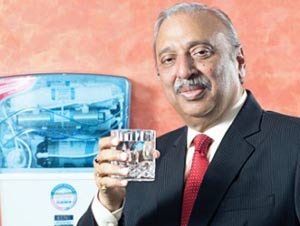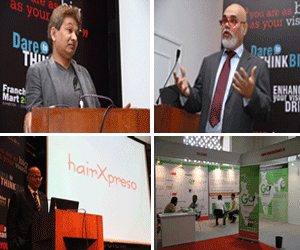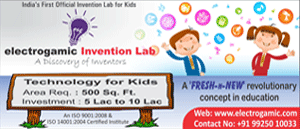Kent is today synonymous with RO Water purifier. Mahesh Gupta talks about how he set up Kent with his modest saving, how he broke stereotypes and his plans for the future.
When both his children suffered from jaundice after drinking contaminated water, Mahesh Gupta was a harried man. Much of his anxiety rose from the fact that he had underestimated the dangers of water borne diseases and now his children were at the receiving end of it. “I never used a water purifier before and suddenly felt the need to have one. I started researching and found that only UV water purifiers were available in the market,” says Gupta.
It was known to Gupta that UV does not remove the particles dissolved in water. “After extensive research I figured out that the process of reverse osmosis (RO) could tackle the problem. I decided to design a purifier for my own house and imported few components like the membrane and a pump from the US,” says Gupta. It, however, was not merely a matter of assembling parts as it took him another three months to design a purifier that was good for his house. “It struck me that what is good for me would be good for everyone else in the country,” says Gupta.
Brush with entrepreneurialism
Gupta benefitted extensively from his education and much credit for Kent’s creation can be given on his learning. A pass out of IIT Kanpur in 1975, Gupta subsequently joined Indian Institute of Petroleum in Dehradun. Passing out in 1977 Gupta joined Indian Oil Corporation as an engineer and worked on the conservation of fuel. “My job involved traveling to different industries and educating them on the methods to save oil,” Gupta says.
Gupta’s first tryst with entrepreneurship came in 1988 when he realized he wanted to do something of his own. “I wanted to start a business which could work in the conservation of oil. I started a company called SS Engineering, which developed products to save oil,” says Gupta. With a modest saving of Rs 20,000, Gupta started the business from his backyard. At a turnover of about Rs. four crore and employing about 40 people Gupta did well and settled down into his comfortable and palpable settings of his business life until his children felt sick.
Start of Kent
Gupta jokes that oil and water does not mix and it is very surprising that the both the businesses that he runs today are poles apart.
“The second business I was to embark upon was more by accident after my children became ill,” says Gupta. His confidence was based primarily on the product he had designed for his house.
“I decided to manufacture and market it for consumers and get into the water purification business. People called me crazy since the cost of these purifiers were so high that it was a given that no one would buy it. A purifier came for about Rs. 20,000 while a gravity purifier was available for a maximum of Rs. 4000. However, there were some who bought the product and the feedback I got was very positive. It helped reduce abdominal pains in many individuals while some even claimed to have seen improvements in blood pressure,” he says.
Things, however, were tough for Gupta as the first month Gupta barely managed to sell two units and the first year of operations he hardly did a few lakh in sales.
Never let go:
Gupta comes across as someone who does not give up and has the conviction to carry on. “Many a times I thought of quitting and I was starting to question the relevance of the product. However, at the same time I had the will to carry on and persevere since I believed that the product could work if I gave it enough time. I named my company Kent RO Systems with a strong belief that RO was the system which would differentiate us in the market,” says Gupta.
Gupta’s biggest spanner was that he had no knowledge of the market and had very little idea about how to sell in the consumer space. “I was operating an industrial product manufacturing company and was never in the consumer space. Here I was trying to sell a product to consumers and very frankly had very little idea about how to go about it. On the other hand my competitor was almost synonymous with water purifier and it was proving extremely difficult,” says Gupta.
Gupta persisted in very tough conditions and what worked was that he started getting publicity through word of mouth. “People who used it would recommend it to friends and family and slowly the word spread. Soon we started doing some exhibitions and also came out with small advertisements across publications,” says Gupta.
Reinventing the product:
“I am a scientist and a keen observer of things. The first product that we made was a under the counter purifier where the product had to be installed below a sink and was very heavy. It was a western approach where they never put anything on the wall but believe in concealing the products. My initial product was similar but I realized it will not work in India,” says Gupta.
According to him people in India do not do dry kitchens but prefer wet ones. After every cooking people generally prefer to wash or wipe their counters. Anything put on the counter or under the counter would not work. “I was the first RO company in the world to develop a product which could be mounted on the wall, which suited Indian customers well. This made it a lot easier to sell the product. The early products, however, were not made of plastic and were made of stainless steel,” says Gupta.
That, however, was not the end of Gupta’s problems. “There are two types of impurity in the water – one which gets dissolved and the one which does not. Hard water with calcium and magnesium is very common and these are dissolved impurities of water. One disadvantage of RO purifier was that when it was removing dissolved impurities it was also removing essential minerals,” says Gupta.
In the year 2005 Kent came out with a product called Mineral RO, which would keep the essential mineral intact and purify the water. Kent also holds a patent for it.
Market Mix:
At the heart of every consumer facing product is the need to advertise and market. Gupta realized that to be successful and have a brand equity he needed to advertize.
“By 2006 I realized to make the product work I needed to get into serious advertising and marketing. We needed a well known, popular house lady and a mother to advertise and we zeroed in on Hema Malini,” he says.
By that year the company had expanded to other metros and Gupta started rolling out mass media campaigns. His strategy worked as Kent became a household brand with revenues of Rs. 30 crore for that year. “Since then I have been growing every year at 30-40 percent. I feel we will continue to grow at this pace for a few years to come,” says Gupta. He has since them entered the mass selling gravity purifiers as he carries on a sales push to the electricity starved rural India. Kent has also come up with a vegetable purifier, a water softener for washing machines and air purifiers.
“ROs still contribute about 85 percent of the revenue but other segments are also doing well. We have not touched even one percent of the population with our RO and the opportunity for us is huge as humans continue to contaminate the water sources. We are closing the year with Rs. 450 crore in revenues and present across most of the 600 districts in the country.
Son rise:
After his graduate studies in Computer Science at Purdue University Varun Gupta joined the family business in 2005. “Once I came back I was assigned to the factory floor to learn the business. I used to look at production and slowly started getting involved in planning the production, what to produce, what not to produce in consultation with the sales team,” says Varun.
Learning on the job he soon grew to handling all procurement from different Indian suppliers and then started looking at international purchases. “The timeline for international purchases involves a lot of planning and takes time,” says Varun.
Varun also bought with him a fresh air of change and contemporary thinking. Drawing heavily from his computer science background Varun tried to list the shortcomings in the company. “When I was doing all this I saw the company was conducting its business largely on paper with hardly any systems in place. There was duplicity of information in planning, sales and others and I thought it was time we had a centralized system where the entire company can access information. I went ahead to install the ERP system for the company in 2007-08, which meant all the department of the company operated on one system,” says Varun. In 2010 Varun took a break and went on to do his MBA from Columbia Business School and returned back to the company after a year and half. Primarily in charge of marketing, sales and exports, Varun says the outlook for the company is strong and he is looking at bringing certain changes to the company’s operations.
“We sell products through tradition routes like standard retail model where products are showcased in retail shops. We also have direct selling where we have our people doing sales door-to-door. I am putting more focus now on finding alternate routes for sales. We have started a corporate and institutional sales department last year which has shown good progress. We did a slow start with tying up with online retailers and have started with our own e-commerce platform. The idea is now to revamp it to a larger scale,” says Varun.
Varun is heir apparent to manage Kent after his father and he is sure about what he has to achieve. According to him in the last ten years of operations, direct sales were a stronger route for Kent to sell products and not so prominently placed at retail level. “My thrust is also now on retail level to increase our visibility. Exports are another area that I am trying to grow,” says Varun.
Exports are about 3-4 percent of Kent’s annual sales but Varun wants to grow it to 8-10 percent in the next couple of years. Bangladesh, Sri Lanka, Dubai and countries in Northern Africa are the main markets and the company is in the process of setting up a export department. “Our product is good for any country. We are not targeting Europe or the US because water is clean there. But developing countries have the problem of clean water and our product is a good fit,” says Varun.
Kent & Franchising
To strengthen its retail presence across the country Kent went for the franchising route in 2003 through its exclusive stores termed ‘Kent Shoppe’. A look at their franchising model:
Responsibilities of Franchisee
Showroom will be operated by franchisee.
Showroom will be owned/rented by the franchisee.
The franchisee will do all the interiors as per the design provided by Kent (Cost of the interior will be paid back by Kent in installments).
Franchisee should invest in sufficient stock of Kent Products.
Franchisee should actively participate in the enterprise to ensure the targeted sale, minimum 25 RO units/ month. He should have the capacity to monitor the sales people.
Franchisee to ensure a godown adjoining the store or at another convenient location to stock the goods.
Products should be marketed and displayed on shelf’s in the showroom.
Franchisee will sell only directly to customers and will not do distribution.
Franchisee will sell only Kent brand and will not display or sell any other product other than Kent brand products.
Responsibilities of KENT
Kent will provide backlit dealer boards.
Kent will provide product dummies (wherever feasible) or product at 50 percent concession for display.
Installation will be provided by Kent’s authorized representative or by the service franchisee.
After sales service will be provided by Kent or by the authorized service franchisee of that area.
Kent will provide one in-shop promoter.
Performance Expectations
Kent expects the showroom to do a minimum Of Rs. 10 lakh/month sales of all products put together, which should go up to Rs. 15 lakh/month by the end of 1st year.
Profitability
There is approx 20 percent margin for the franchisee. On a sale of Rs. 10 lakh/month, a clear margin of Rs. 2 lakh/month will accrue. Net profit after rent will be in the range of Rs. 9 lakh/annum to begin with and is likely to grow further.
Servicing and Installation
The service and installation will be done by an authorized service franchise. However if the franchisee does a business of Rs. 10 lakh/month then he may considered for service franchisee which will be an extra source of income.
Expected Investment
The Franchisee is required to bear the entire cost of interior designing. This is expected to be approx Rs. 5-6 lakh. This cost will be reimbursed in 36 equal monthly installments or of 10 percent of monthly purchase value from Kent, whichever is lower.
Sales will be on cash and carry basis. Billing will be done only once the payment is credited into Kent’s accounts.
Franchisee is required to invest an amount ranging between Rs. 5 to 6 lakh to maintain adequate stocks.
Conditions of Operations
The franchisee is required to undertake the following:
To personally supervise and monitor the staff and operate the showroom
To provide and utilize a showroom for exclusive use Kent products only.
To bear the entire running cost of the shop.
To maintain adequate stock of Kent products.
To maintain a separate godown near the Shoppe or at a convenient location.
To operate the shop for minimum period of 36 months from the date of operation.
To follow all the rules and regulations of the Kent Shoppe.
To sell directly to consumers only and not distribute Kent products to retailers/resellers.
How to Get Started
If the franchisee meets the above requirements he should fill up the franchise form and send it to Kent. He should have an investment capacity of Rs. 5 to 6 lakh for doing interiors of showroom as per Kent’s design and should also invest Rs. 5-6 lakh for goods storage.
The investment on the interior would be paid back by Kent by giving credit note of 10 percent of the value of products purchased (till the 100 percent investment is returned). On successful selection, the franchisee would pay an advance of Rs. 3 lakh, which would be adjusted in the first supply of products.































 +91 9909960054
+91 9909960054